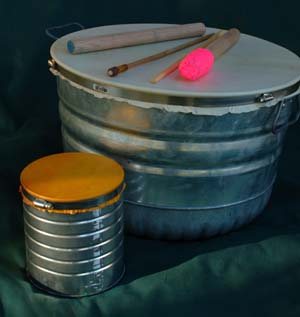A Guide To Creating Your Own
Rhythms
By
Jim Donovan
Part 1 Pulse, Cycles, Subdivision, Space and Accents
1. Find a pulse or a tempo you’d like to use.
A good place to begin is to take walk around the room you’re in and
clap each time you take a step. This is what I refer to as a normal
walking tempo. After you find a pulse, you are going to use it as your
foundation or reference point from which you can begin your rhythm
creation.
Musicians will often use counting as a way to keep their place within
a pulse. They will count it like this: one, two, three, four, one, two,
three, four….
This kind of pulse is called a four-beat cycle. There are other kinds
of cycles, but for our purposes today, we’ll just use a four-beat.
Once you establish a pulse, then the fun begins! A pulse can be
manipulated in all sorts of interesting ways.
2. Subdividing the pulse.
Within a pulse are a wide variety of ways to expand rhythmic
possibilities. Adding equidistant beats within a pulse is a good starting
point.
a. Doubling: Find your original pulse. You’ll notice a space in
between each beat in the original pulse. Double the speed of
your pulse by putting one beat in each space.
You can count it like this: one and two and three and four and one
and two and three and four and….
b. Quadrupling: Same idea as doubling, except you put four
equidistant beats within the space of each beat in the original
pulse
You can count it like this: one ee and ah two ee and ah three ee and
ah four ee and ah.,..
3. Create spaces in the subdivision
Once you understand how to do simple subdividing of a pulse, you
can begin to create interesting rhythmic variations by establishing a
subdivided pulse and allowing a few of the beats to go by in silence.
As you the silent beats pass, continue to allow them to pass in
silence in the same spot each time the cycle repeats.
For example:
If you are using a quadrupled subdivision (better known and 16th
notes), you could put silence on the “ee” each time it occurs in the
cycle.
One, silence, and ah, two, silence, and ah, three, silence, and ah,
four, silence, and ah… etc.
4. Accenting parts of the subdivision
Instead of making some of the beats in your subdivision silent, you
can go the opposite way by accenting, or increasing the volume of
some of the beats.
For example:
If you are using a doubled subdivision (better known and 8th notes),
you could put an accent on the “and” each time it occurs in the cycle.
I will use all CAPS to denote an accent. In music you might also see
the symbol “>” over a group of notes to signal an accent.
one, AND two, AND, three, AND, four, AND… etc.
5. Using voicing
Voicing means determining what sound you’ll on specific beats. A
simple way to use voicing is to pick two different sounds (preferably
a low sound and a high sound), then assign one sound to your right
hand and the other to your left hand.
Next, play your rhythm by simply alternating your hands R,L,R,L. As
you play the rhythm you’ll notice that even though the pattern is the
same, the use of 2 distinct voices changes the way you experience
the rhythm. Voicing is quick and easy way to create infinite variation
rather effortlessly.
6. Using handing patterns with voicing
Handing refers to the pattern your right and left hands are performing.
The standard handing is simply to alternate your hands “right, left,
right left”. Where this gets interesting quickly when you start using
different handing patterns on different voices. Even the simplest
handing pattern can really spice up an otherwise boring rhythm.
Try this:
Pick two different sounds (preferably a low sound and a high sound),
then assign one sound to your right hand and the other to your left
hand. Then perform the following handing patterns.
RRLL RRLL
RLRR RLRR
RLRR LRLL
RLLL RLLL
 Tube drums, made from heavy cardboard cylinders are currently THE RAGE, thanks to facilitator and founder of the Eldermusic group at Yahoo, Annie O'Shea.
Tube drums, made from heavy cardboard cylinders are currently THE RAGE, thanks to facilitator and founder of the Eldermusic group at Yahoo, Annie O'Shea.  Tube drums, made from heavy cardboard cylinders are currently THE RAGE, thanks to facilitator and founder of the Eldermusic group at Yahoo, Annie O'Shea.
Tube drums, made from heavy cardboard cylinders are currently THE RAGE, thanks to facilitator and founder of the Eldermusic group at Yahoo, Annie O'Shea.  When working with groups, it is very useful to have a wide range of timbres available, that the group might behave somewhat like a band or orchestra. its very helpful to have a 'Mama' drum of some sort, holding down the bottom so the other instruments can float around and experiment.
When working with groups, it is very useful to have a wide range of timbres available, that the group might behave somewhat like a band or orchestra. its very helpful to have a 'Mama' drum of some sort, holding down the bottom so the other instruments can float around and experiment. 
 The coffee can drum is a portable, versatile, inexpensive drum, an ideal "first Drum project. It responds well to a thin stick, with techniques that vary from scrapng and striking the side of the can to one hand/one stick techniques not unlike those used on sabar, Mandinka drums, or certain Brazilian instruments..
The coffee can drum is a portable, versatile, inexpensive drum, an ideal "first Drum project. It responds well to a thin stick, with techniques that vary from scrapng and striking the side of the can to one hand/one stick techniques not unlike those used on sabar, Mandinka drums, or certain Brazilian instruments..